 Warmans Roseville
Warmans Roseville
Pottery 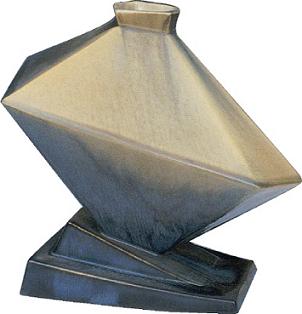 MARK F. MORAN Identification and Price Guide 2004 Krause Publications
MARK F. MORAN Identification and Price Guide 2004 Krause Publications
Published by  700 East State Street Iola, WI 54990-0001
700 East State Street Iola, WI 54990-0001
715-445-2214 888-457-2873
www.krause.com Our toll-free number to place an order or obtain a free catalog is 800-258-0929. All rights reserved. No portion of this publication may be reproduced or transmitted in any form or by any means, electronic or mechanical, including photocopy, recording, or any information storage and retrieval system, without permission in writing from the publisher, except by a reviewer who may quote brief passages in a critical article or review to be printed in a magazine or newspaper, or electronically transmitted on radio or television. Library of Congress Catalog Number: 2003111772 ISBN: 0-87349-752-X
eISBN: 978-1-44022-621-2 Designed by Jamie Griffin
Edited by Dennis Thorton Printed in USA Warmans Roseville Pottery
Patterns (alphabetically)
A Six-Decade Experiment Collectors of Roseville Pottery become quite animated when discussing experimental pieces, those with trial glazes or unusual forms that never went into large-scale production. In fact, the entire 64-year history of the company was one long experiment, first by trying to gauge public tastes, and, finally, by just trying to survive.
Ohio was the center of pottery production in the late 19th century, due to easily accessible waterways and an abundance of raw materials. Natural gas deposits in the Zanesville area, combined with rich clay, provided an ideal foundation for local potteries and gave Zanesville its nickname, Clay City. The Roseville Pottery Company, located in Roseville, Ohio, was incorporated on Jan. 4, 1892, with George F. Young as general manager. B. B.
Owens Pottery, also of Roseville. Wares included flowerpots and cuspidors, and all were unmarked. Venetian baking pans, German Cooking and Farm Ware, the Blended line of jardinires and pedestals, and coin banks and novelties were some of Rosevilles earliest products. The popularity of Roseville Potterys original lines of stoneware continued to grow. The company acquired new plants in 1892 and 1898, and production started to shift to Zanesville, just a few miles away. By about 1910, all of the work was centered in Zanesville, but the company name was unchanged.
Young hired Ross C. Purdy as artistic designer in 1900, and Purdy created Rozanea contraction of the words Roseville and Zanesville. Rozane was a style of brown underglaze pottery that was already popular at the time. Rozane was similar to artwares in production at two other Zanesville potteries: Weller Potterys Louwelsa and the Owens Potterys Utopian. All of these Zanesville firms were imitating Cincinnatis Rookwood Pottery, which had developed its Standard Glaze line in 1884. The first Roseville artware pieces were marked either Rozane or RPCo, both impressed or ink-stamped on the bottom.
In 1902, a line was developed called Azurean, which was similar to Wellers blue Louwelsa: a blue and white underglaze decorated artware on a blended background. Some pieces were marked Azurean, but often RPCO. In 1904 at the St. Louis Exposition, Rosevilles Rozane Mongol, a high-gloss oxblood red line, captured first prize, gaining recognition for the firm and its creator, John Herold. Other artists included Gazo Fujiyamawho created the Woodland, or Fujiyama, line as well as Rozane Fudji. Many Roseville lines were a response to the innovations of Weller Pottery, and in 1904 Frederick Rhead was hired away from Weller as artistic director.
He created the Olympic and Della Robbia lines for Roseville. (He later designed the Fiesta wares for the Homer Laughlin Co.). His brother Harry took over as artistic director in 1908, and in 1915 he introduced the popular Donatello line. By 1908, all handcrafting ended except for Rozane Royal. Roseville was the first pottery in Ohio to install a tunnel kiln, which increased its production capacity. Frank Ferrell, who was a top decorator at the Weller Pottery by 1904, was Rosevilles artistic director from 1917 until 1954.
This Zanesville native created many of the most popular lines, including Pine Cone, which had scores of individual pieces. Roseville patterns introduced under Ferrells direction also include: Futura (1928), Imperial II (1930 glazes), Earlam (1930), Ferella (1930), Sunflower (circa 1930), Montacello (1931), Windsor (1931), Jonquil (circa 1931), Ivory (1932), Baneda (1932), Blackberry (circa 1932), Cherry Blossom (1933), Tourmaline (1933), Artcraft (1933), Falline (1933), Wisteria (1933), Laurel (1934), Topeo (1934), Luffa (1934), Russco (1934), Velmoss II (1935), Morning Glory (1935), Orian (1935), Clemana (1936), Primrose (1936), Moderne (1936), Moss (1936), Thorn Apple (1937), Dawn (1937), Ixia (1937), Poppy (1938), Teasel (1938), Fuchsia (1938), Iris (1939), Cosmos (1939), Crystal Green (circa 1939), Bleeding Heart (1940), White Rose (1940), Columbine (1941), Rozane Pattern (1941), and Bushberry (1941). Many collectors believe Rosevilles circa 1925 glazes were the best of any Zanesville pottery. George Krause, who had become Rosevilles technical supervisor responsible for glazein 1915, remained with Roseville until the 1950s. Company sales declined after World War II, especially in the early 1950s when cheap Japanese imports began to replace American wares, and a simpler, more modern style made many of Rosevilles elaborate floral designs seem old-fashioned. In the late 1940s, Roseville began to issue lines with glossy glazes (Wincraft, Ming Tree, Artwood, and Lotus).
Roseville tried to offset its flagging artware sales by launching a dinnerware lineRaymorin 1953. Raymor was designed by Ben Siebel, but the style was rather austere when compared to better-selling dinnerware, and the line was a commercial failure. Roseville issued its last new designs in 1953. On Nov. 29, 1954, the facilities of Roseville were sold to the Mosaic Tile Company. Condition and Pricing Since many of the Roseville pieces listed in this book were sold at auction, the descriptions are very detailed, down to the length of hairlines and the position of flea-bite nicks.
Most price guides list values assuming a piece is in mint condition, but the prices here reflect the reality that very few examples of pottery survive for decades without at least minor wear or damage. Reproductions Since the mid-1990s, Roseville Pottery fakes and reproductions have been a growing problem. The best way to learn about reproductions is to visit The Roseville Exchange, whose motto is dedicated to helping the public spot reproduction (fake) Roseville Pottery. You can find it online at http://www.ohioriverpottery.com/roseville_exchange/roseville.html. The site offers information on hundreds of reproductionswith style numbers and imagescontributed by collectors, and side-by-side comparisons with real pieces. Words of Thanks This book would not have been possible without the generosity of: David Rago Auctions,
333 N.
Main St.,
Lambertville, NJ 08530.
Phone: (609) 397-9374.
Fax: (609) 397-9377.
Web site: http://www.ragoarts.com/.
E-mail: info@ragoarts.com. The Iridescent House,
227 First Ave. SW,
Rochester, MN 55902.
Phone: (507) 288-0320.
Web site: http://www.iridescenthouse.com. Adamstown Antique Gallery,
2000 N. Reading Rd.,
Denver, PA 17517.
Phone: (717) 335-3435.
Web site: http://www.aagal.com/. Antiques of Red Wing,
Next page
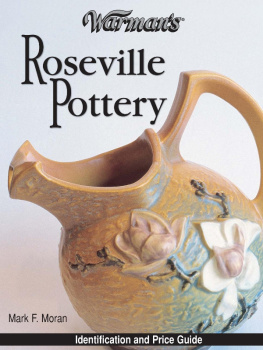
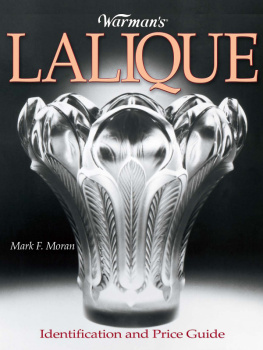

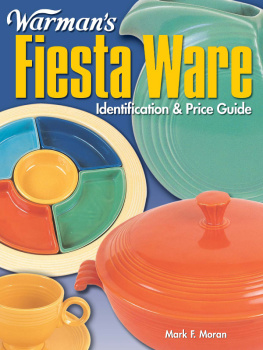

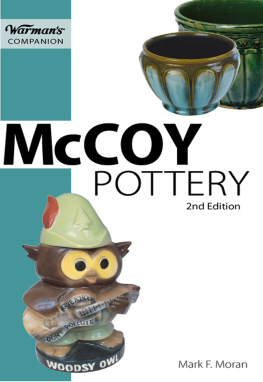
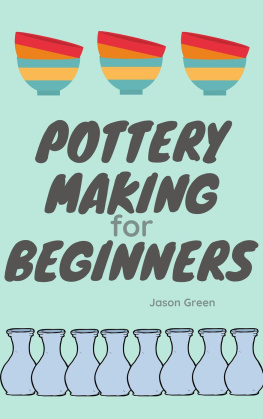
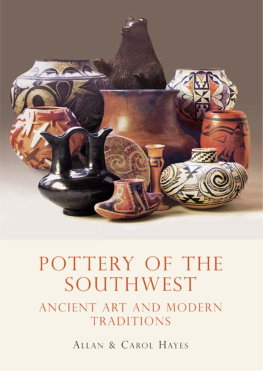
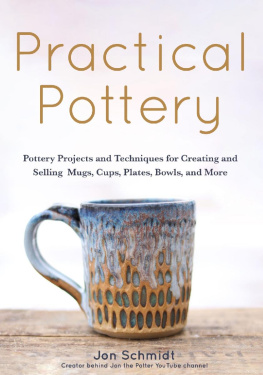
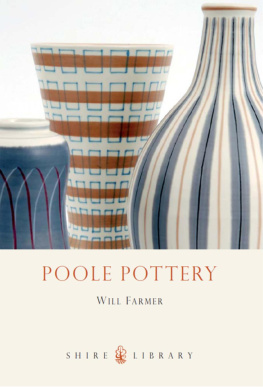

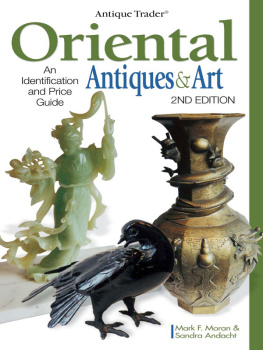

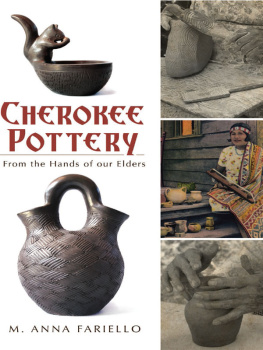
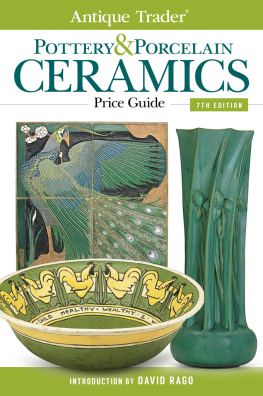
 Warmans Roseville
Warmans Roseville MARK F. MORAN Identification and Price Guide 2004 Krause Publications
MARK F. MORAN Identification and Price Guide 2004 Krause Publications 700 East State Street Iola, WI 54990-0001
700 East State Street Iola, WI 54990-0001